This was published 8 years ago
Train ride around Yangon: Riding the rails of Myanmar
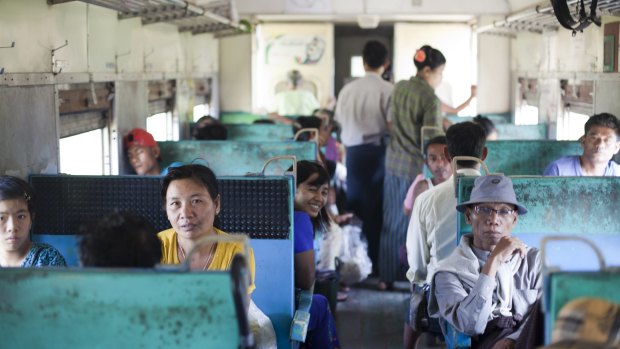
The interior of the Yangon train is hardly luxurious.Credit: Guy Wilkinson
It's not that I'm plagued by a sense of danger, yet somehow it's always there; that inherent sense that if I'd been doing this only a few years ago, I would likely have been tossed in jail or even shot.
Until 2010, Myanmar didn't take kindly to foreigners; especially those taking photos on a public train, but the times it seems, they are a-changin'.
Yangon Station is a heaving mass of people jockeying for position; men haul sacks of rice on their shoulders, weaving among the throng while others balance wicker baskets filled with dried fish on their heads.
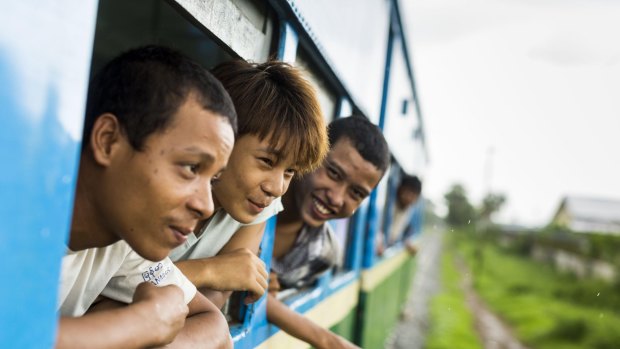
Passengers lean out of the windows of the Yangon Circular Train. Credit: Alamy
I am on the circular rail line, a 38-station loop connecting the outer suburbs of Yangon with the city centre. With me is my guide, Thura Lwin, a 20- something student of mechanical engineering with an impressive grasp of English and local culture.
The train is packed but Lwin has already bagged us a seat.
Despite the early hour and the largely ineffectual ceiling fans whirring above, there's an ominous humidity already creeping through the open windows. The metallic blue seats, chipped and faded, would hardly be at home on The Oriental Express, but there's a buzz about the carriage that eclipses any creature comforts.
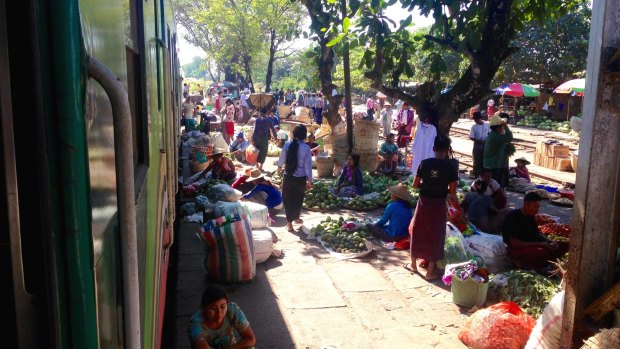
Markets alongside Yangon's 38-station railway loop connecting the outer suburbs with the city centre. Credit: Annie Dang
Around us, passengers chat over thermos flasks of tea or read the morning papers. Beside me, a man dressed in a longyi and crisp white shirt clutches an umbrella and a worn leather satchel. Above his head, a sign reads, "No Litter, No Smoking—and somewhat bizarrely—No Kissing."
In a matter of minutes, we're at the first station where I notice a man out cold on a hammock fashioned from bricks and planks of wood. A mean, feral looking rooster pecks at scraps beside him.
"Many of them are bred to fight," explains Lwin. "Gambling on cockfighting is still a big pastime here."
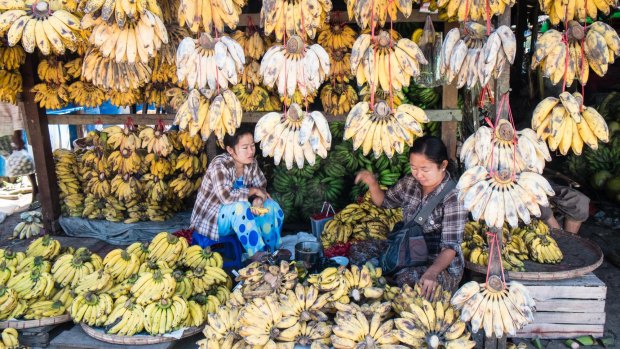
Bananas at a fruit and vegetable market alongside the Yangon's circular rail tracks.Credit: Alamy
Rattling our way further out of Yangon, the train rocks violently from side to side as the scenery morphs steadily towards a more bucolic backdrop.
We pass glittering rice paddies, watercress farms, thatched huts doubling as teahouses and restaurants, rickshaw drivers dozing beneath bridges, and run down apartment blocks beside monasteries flush with gilded roofs and gold lace windows. Occasionally the waft from makeshift bonfires along the dusty roadside drifts in through the carriage.
At Danyingon Station we hop off. Lwin leads me down a wobbling boardwalk into a labyrinth of market stalls offering respite from the midday sun. Instantly, the potent smell of shrimp paste is overpowering.
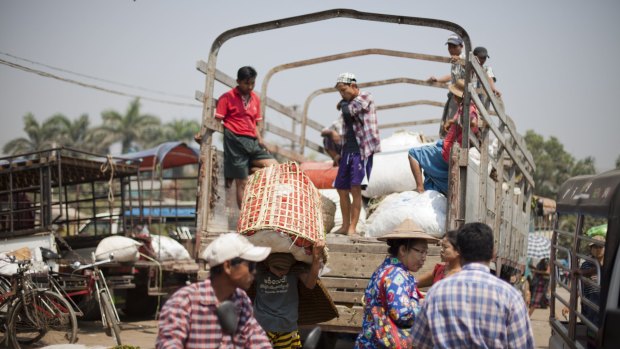
Workers load goods onto truck Danyingon Railway Market.Credit: Guy Wilkinson
In the relative darkness, I can just make out tables piled high with copper-coloured spices, baskets of brilliant red chilli peppers and strangely unidentifiable mounds of fermented fish.
Pausing for a time out, we stop at a teashop on the outskirts of the main hub.
Pulling out a stool from beneath a low wooden table, a rooster flutters about my feet, agitated by the disturbance. Men smoking strong tobacco make kissing noises as a kid with a dyed-red mohawk darts between tables. Apparently, to my considerable mirth, this is the preferred method of attracting a waiter's attention in Myanmar.
Across from our table, an Indian monk fixes me with an intense, glassy-eyed stare. Dressed in a saffron turban, thick wooden beads slung around his bare torso, it's hard to ignore the solid metal spike piercing both his cheeks.
Back at the station, we're half an hour early for the afternoon train home. When I ask if our punctuality is perhaps overkill, Lwin is quick to dispel my concerns.
"Sometimes the train is early, sometimes it's late," he says. "But if it's early, often the drivers can't be bothered to hang around, so they just take off."
On the tracks people sell bags of sour leaves and herbs. Periodically, a brain-rattling announcement crackles over the tannoy resulting in a hurried mass exodus. Seconds later a fast train thunders through to a blaze of horns, leaving us to choke on the plume of dust in its wake.
When we finally roll back into the city, I'm genuinely sorry to part ways with Lwin. Having been isolated from the outside world for so long, Myanmar is a country where even a simple train ride takes on a special resonance.
It's a place where so much and so little has changed all at the same time.
TRIP NOTES
MORE INFORMATION
GETTING THERE
Thai airways fly direct from Sydney to Bangkok with convenient ongoing connections to Yangon, see www.thaiairways.com
TOURING THERE
The Let Yangon Take You For a Ride rail tour lasts between 6-7 hours with an 8.30am pick up from the Asia Plaza Hotel. From $51. See www.urbanadventures.com
The writer was a guest of Intrepid Travel, Urban Adventures and ASEAN (Association of South East Asian Nations), of which Myanmar is a part of.
Sign up for the Traveller Deals newsletter
Get exclusive travel deals delivered straight to your inbox. Sign up now.